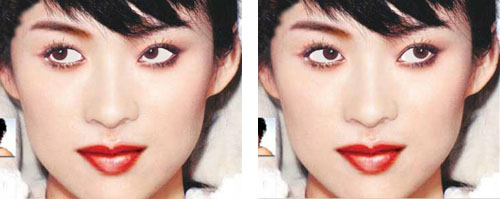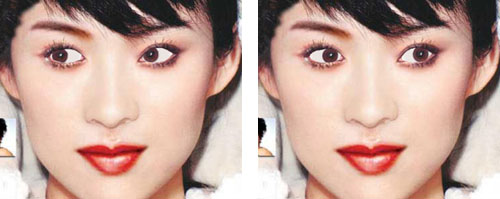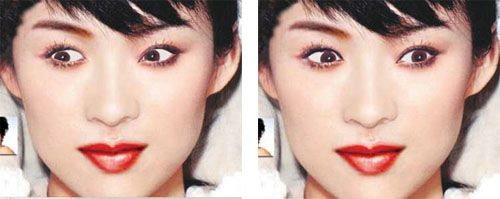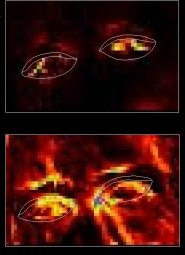
by Nguyen Tam
We have all met people who were dishonest and avoided eye contact. It has been said that "the eyes are the mirror if the soul." Many people know that their eyes betray their lies. Some try to conceal the truth by wearing sunglasses of looking down at the ground.
Eventually, you will confront someone and need to know if they are being honest. It may be a friend, a family member or an employee. Police have established a method of evaluating the truthfulness of a person by watching the movements of their eyes. It's not an exact science by any means, and it can be manipulated by a skilled criminal or a seasoned liar, but is it generally accepted as a good indicator of honesty.
The following are some general patterns that you can use when talking to someone. It shows the various directions of eye movements of a person and explains what is usually going on in their mind at that moment. It illustrates that a glance to the observer's left usually reveals a creative process -- when someone is "making up" facts or lying. A glance to the observer's right reveals that the subject is remembering facts.
Here is a more detailed explanation of this method:

Up and to the Left: Indicates a visually constructed Images. If you asked someone to "Imagine an ice cream sundae with a red cherry on top", this would be the direction their eyes moved. In their mind they are "Visually Constructing" an ice cream sundae with a cherry in their mind.
Up and to the Right: Indicates a Visually Remembered Images. If you asked someone to "What color shirt or blouse did you wear yesterday?", this would be the direction their eyes moved. In their mind they are "Visually Remembering" the color.

To the Left: Indicates an Auditory Construct thought. If you asked someone to "Try and ceate the sound of a speeding train in your head", this would be the direction their eyes moved. In their mind they are imagining and creating the sound of a speeding train.
To the Right: Indicates an Auditory Memory. If you asked someone to "Remember what the National Anthem sounds like", this would be the direction their eyes moved in while remembering the song.

Down and to the Left: Indicates a Feeling / Kinesthetic / Sensory impression that is being created. If you asked someone to "Can you remember the taste of chocolate?", this would be the direction their eyes moved in while they recalled a smell, feeling, or taste of eating chocolate.
Down and To the Right: Indicates an Internal Dialog. This is the direction of someone's eyes as they "talk to themselves."
How to use this information to detect a lie?
Let's say that you have a friend who owes you some money. You have heard that they just got paid and you want to suggest that they pay you back. You try to be polite and ask them, "Did you get paid yet?" They answer, "Gee, not yet. The boss said maybe next week." and look to their right (your left). This would indicate that they are constructing or "making up" what their boss said. They are telling a lie.
Police often ask a suspect to describe someone in detail. If the suspect looks to their right (your left) they are generally constructing or "making up" the visual description. If they look to their left (your right) they are generally recalling the details from their visual memory.
So, in general, a glance to your left when observing a person indicates that they are creating or "lying" while a glance to your right signifies that they are remembering an actual event, or being "truthful."
But ther's more to the story...
Another thing that forensic interrogators look for is the use of contractions -- words like isn't, doesn't, weren't, etc. These usually are used by people telling the truth. On the other hand, people who say is not, does not, were not, etc. are often lying.
They also look for the reactions and facial expressions that accompany what the person is talking about. If someone says "I'm so sad that it happened!" but there is a delay in their expession of sadness, they are probably not being honest. The example is often given of someone who receives a present that they don't like. They often respond with "Wow. It's beautiful, I love it!" and then, some few seconds later, they smile and appear to look happy. Truthful emotions are spontaneous and instantaneous.
Another method used by professionals is to change the subject. A person who has been telling lies about a particular event will welcome the change of topic and will be visibly relaxed. An innocent suspect or a person who has been telling the truth will usually want to continue the dialog and will find the change of topic puzzling and attempt to regain focus on the topic.
Body language is also a good thing to observe. Liars usually do not use their hands. They often fold their arms together in front of them or poition items such as books, cups or other things between themselves and the person asking the questions. Sometimes they touch their mouth or nose alot.
Some investigators say that long and detailed answers to otherwise simple questions can indicate a lie. It's as if the more detail the person gives the more he tries to convince the questioner that he is being truthful. If they are confronted or acused of something, the liar will usually deny the accusation in a calm and emotionless manner instead of getting excited and saying things like "What? You think I did it?"
With careful video analysis, some investigators can observe rapid twitches in facial muscles that indicate a lie. Poker players often learn to "read" the facial expressions or "ticks" of other players to determine if they hold a good hand of cards or are just "bluffing."
To become adept at distinguishing lies, ask some neutral questions to establish the baseline of the subject. Watch their facial expressions and eye movements and test this method by asking questions and observing the pattern of shifts to left, right, up and down.
A word of caution: this method may be reversed in left-handed people. It also may not apply to people who have rehearsed their answers or who have taken drugs or consumed alcohol.
Update: Blood in cheeks reveals liars
Many people blush when they are telling a lie. It's a very subtle phenomenon but this slight increase of blood flow to the cheeks can be detected. A camera that detects liars by monitoring the temperature of their face could lead to more acurate detection of terrorists and illegals at airports and border crossings.
 Norman Eberhardt and James Levine of the Mayo Clinic and Ioannis Pavlidis of Honeywell Laboratories, both in Minnesota, have developed the high-resolution thermal imaging camera. This can identify an instant rush of blood to the area around the eyes, a phenomenon that has been linked with lying.
Norman Eberhardt and James Levine of the Mayo Clinic and Ioannis Pavlidis of Honeywell Laboratories, both in Minnesota, have developed the high-resolution thermal imaging camera. This can identify an instant rush of blood to the area around the eyes, a phenomenon that has been linked with lying.
In the image on the top [right] the normal blood flow pattern can be seen and contrasted with the increased blood flow (bottom image) of a peron who is lying.
The temperature of the eye region can rise by several degrees. However, the thermal camera needs to be many times more sensitive to detect this change accurately at a distance. In tests the system picked out liars with comparable accuracy to conventional polygraph equipment, which is more complicated and time consuming to use. This method is just beginning to be used in forensic environments and holds promise for the future.
src:http://www.mondovista.com/liar.html
src="http://pagead2.googlesyndication.com/pagead/show_ads.js">

2 comments:
Interesting!!
nice article!
Post a Comment